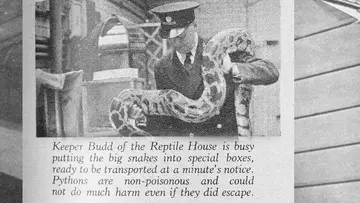
Animal and Zoo Magazine was the official magazine of ZSL neary 100 years ago.
Take a look at some photographs from the November 1939 issue, showing London Zoo at the start of the Second World War.

London Zoo during World War Two
Preparations
War broke out on 3rd September 1939. At 11.00am the Zoological Gardens were closed by order of the Government, as were all other public places where people gathered in large numbers.
The Zoo had been preparing for war for some time. Zoo records show that at the beginning of September 1939, some of the Zoo’s most valuable animals were transferred to Whipsnade for safety; two giant pandas, two orang-utans, four chimpanzees, three Asian elephants and an ostrich.
All the venomous animals were killed to remove the possibility of having dangerous animals escape if the Zoo were bombed. However, some reptiles were saved, among them the Komodo dragon and Chinese alligators. Two large wooden boxes 8ft long by 4ft wide and 2ft deep were built to accommodate two huge pythons, one 28ft long and the other 25ft long.
On the 15th September, the Zoological Gardens reopened, but the aquarium remained closed. This was partly on account of the danger should it be bombed and partly due to the high costs of running it.

The war brought shortages of many things, chiefly fuel and food. To save on petrol, the camels and llamas were used to carry fodder across the Zoo to the animal houses and the Shetland ponies were used for short journeys outside the Zoo.
Certain types of food became difficult to get. The Zoo had to breed its own mealworms for the insectivorous birds and mammals instead of importing them from Germany. Fish was very expensive and some animals like pelicans had to be persuaded to eat meat coated in fish liver oil.
However, positive steps were also made to ensure that there was enough food for the animals. An appeal was broadcast on the radio asking people to gather acorns to supplement the diet of some animals. Acorns poured in at a rate of one ton a week and were fed to the agoutis, squirrels, monkeys and deer. Wheat and other crops were grown on this land to provide food for the herbivorous animals.
Another success was the ‘Adopt an Animal’ scheme. Members of the public and organizations were invited to pay for the keep of an animal of their choice. In 1940 a dormouse, for example, cost a shilling a week to feed, while an okapi or sealion cost £1.10.0d. The adoptions were very popular despite the fact that many people had been evacuated, and there were fewer visitors to the Gardens. Although animal adoptions were set up as a temporary measure to get the Zoo through a lean period, the scheme still exists today.
When the Bombing Began
For almost a year after the outbreak of war, things were very quiet. But in August 1940 the air raid warning sounded and this was to happen almost every day for the rest of the year.
The Zoo was bombed several times during the war, sometimes suffering no more than shattered panes of glass, while on other occasions whole buildings were blown up. One such day was 27th September 1940. Several high explosive bombs fell, damaging the Rodent House, the Civet House, the gardener’s office and all the propagating sheds, the North Gate and the Zebra House.
Surprisingly, there were no injuries to any animal, although a zebra and a wild ass with her foal managed to escape. The zebra was later found heading for Camden Town, but was rounded up. On the same night 35 incendiary bombs fell, setting fire to the main restaurant and destroying the Tunnel Bar. Upon the discovery of an unexploded bomb the Zoo was closed for over a week. Later in January 1941 the Camel House was hit, but when the keepers arrived to investigate, the camels were sitting placidly chewing the cud.

For almost a year after the outbreak of war, things were very quiet. But in August 1940 the air raid warning sounded and this was to happen almost every day for the rest of the year.
Despite the bombs, the Zoo tried to carry on as normally as possible like everyone else in the country. By June 1942, the Zoological Society was very worried about its financial losses and wondered if they would have enough money to see them through the year.
A taxi driver told a member of the Zoo’s Council that most people thought that the Gardens were shut and so were not coming to visit. This was overcome by advertising.
Throughout the war the Animal and Zoo Magazine published a series of articles on how to look after pets in wartime, camouflage in animals and articles on how to raise domestic animals for food. The Zoo’s first female keeper, appointed in 1941, also wrote articles on pet care for a Sunday newspaper.
The Zoological Society and its animals survived the war and it continues to be one of the world’s best zoos today.
